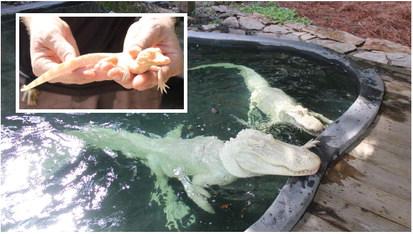If one’s a coincidence and two’s a trend, what is the third time that a rare event occurs in nature?
Earlier this summer, the world’s newest albino alligator baby was hatched at Wild Florida in Kenansville. It marks the third year in a row that proud parents Snowflake, a 25-year-old female, and Blizzard, a 14-year-old male, have seen new hatchlings since the couple was relocated to Wild Florida in 2017.
After two years of trying, 2020 saw four hatchlings, and two in 2021. They are the first pair of breeding albino alligators in Central Florida.
“Wild Florida Airboats and Gator Park is one of only three facilities in the world actively breeding albino gators,” said Andrew Gilhooly, Entertainment Manager for the park.
This year, nine eggs were discovered in the nest built by Snowflake, and the eggs were immediately moved to an incubator so the park’s “Croc Squad” could monitor their progress for the next couple of months. In past years, a naming contest was held for new albino baby gators, and if tradition holds, only winter-related names might be considered. No date has been announced yet as to when the new baby’s name will be introduced to the public.
It is estimated that there are fewer than 100 albino alligators in the world, and only 12 are known to be in captivity. Due to the lack of melanin in their skin, they are completely white and very sensitive to sunlight. Because alligators and most other reptiles use the sun to help regulate their body temperature, albino alligators have trouble in that regard.
The enclosure for Snowflake and Blizzard at Wild Florida is climate-controlled, with both shady areas and a heat lamp to give them the climate options they need depending on the weather.
Albino gators do poorly in the wild, especially at birth. Their bright color robs them of the natural protections the normal camouflage color scheme other baby gators depend on to hide from predators. Even if they survive to adulthood, as ambush predators, their bright color also works against them. In the water, they seem to actually glow. To top it off, albino alligators generally have poor vision, and Snowflake is believed to be completely blind.
The study of alligator genetics actually has important implications for humans. Alligators are large, can have long life spans, and tend to live in the same place over time, similar to humans. Also, humans and alligators share some similar characteristics in their reproductive genes, attain reproductive maturity at similar ages, and have similar spans of reproductive years. Studying the alligator’s very robust immune systems that can have implications for antibiotic and antiviral research and developing new medicines. Alligators never stop growing, which has promise for anti-aging research. These characteristics are some of the practical considerations for the call for comprehensive mapping of the alligator genome to facilitate research applicable to medical benefits for humans.
For more information on Snowflake, Blizzard and the family of albino alligators including the newest addition, go to: wildfloridairboats.com/ blizzard-snowake-aboutalbino-alligators





